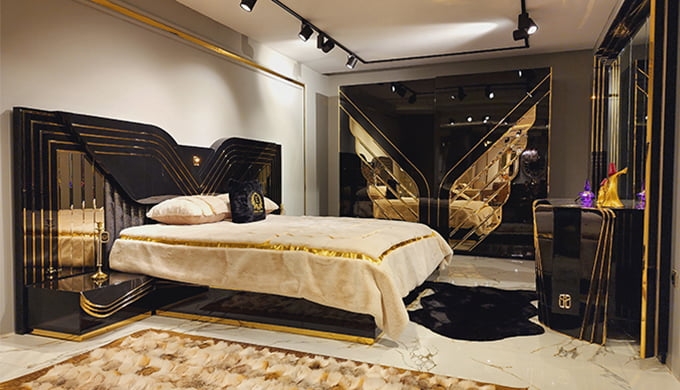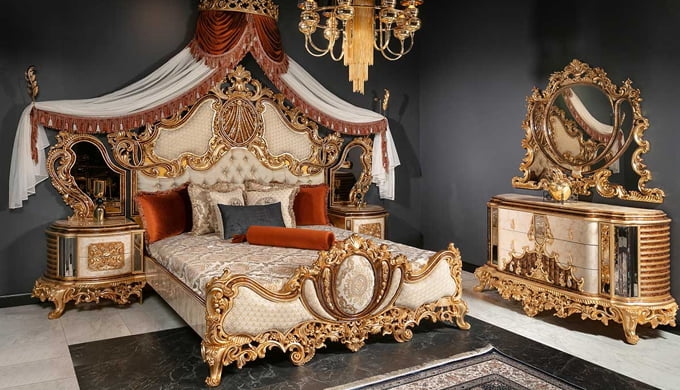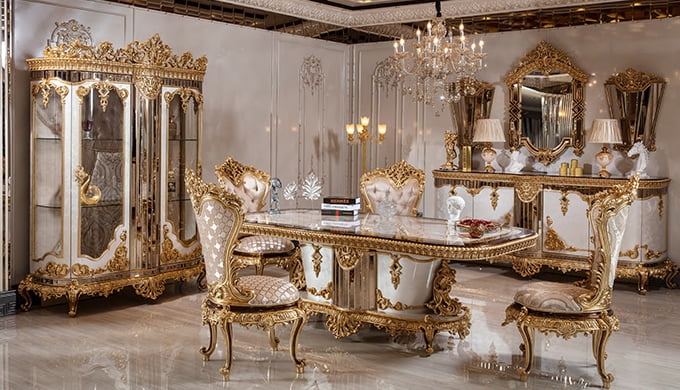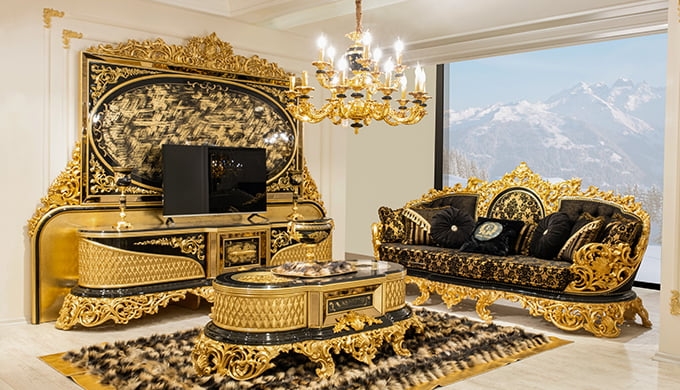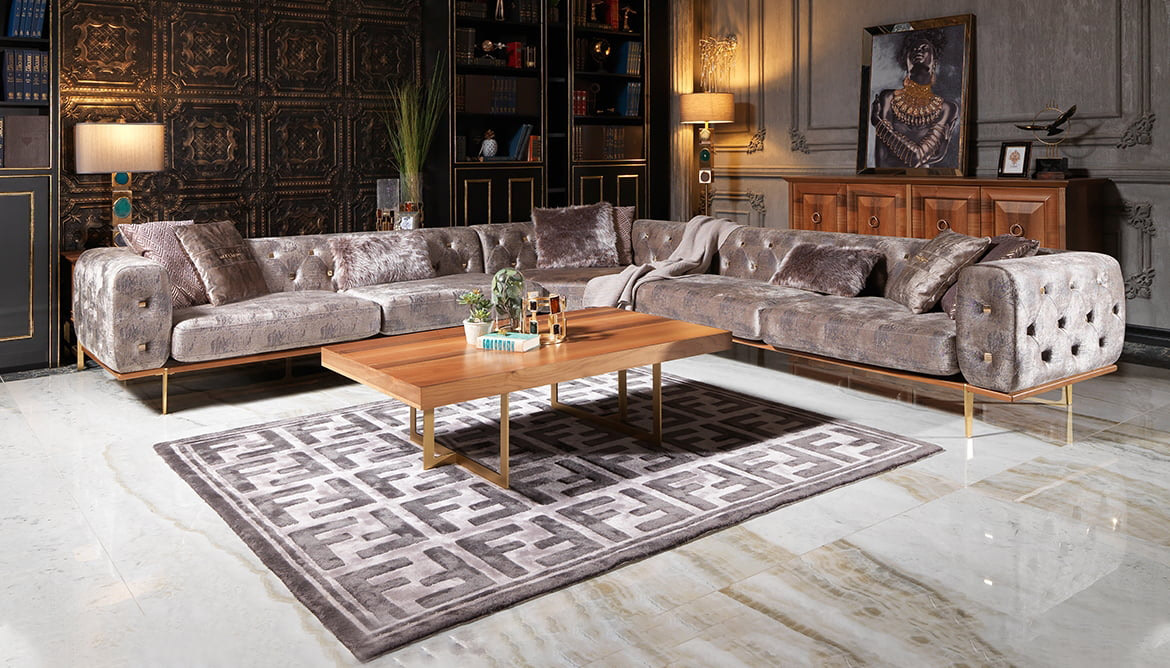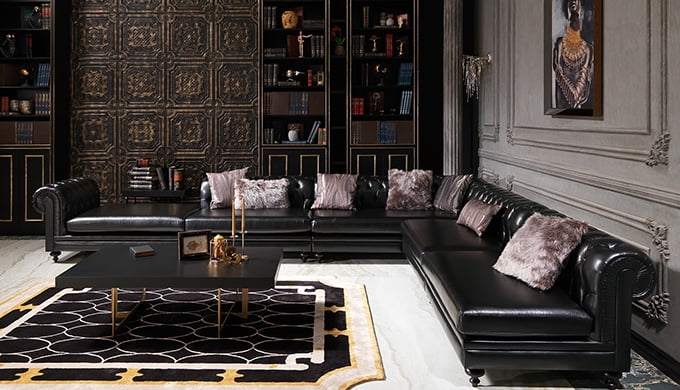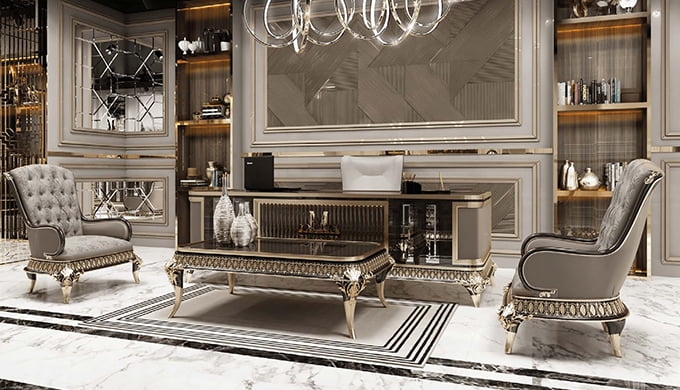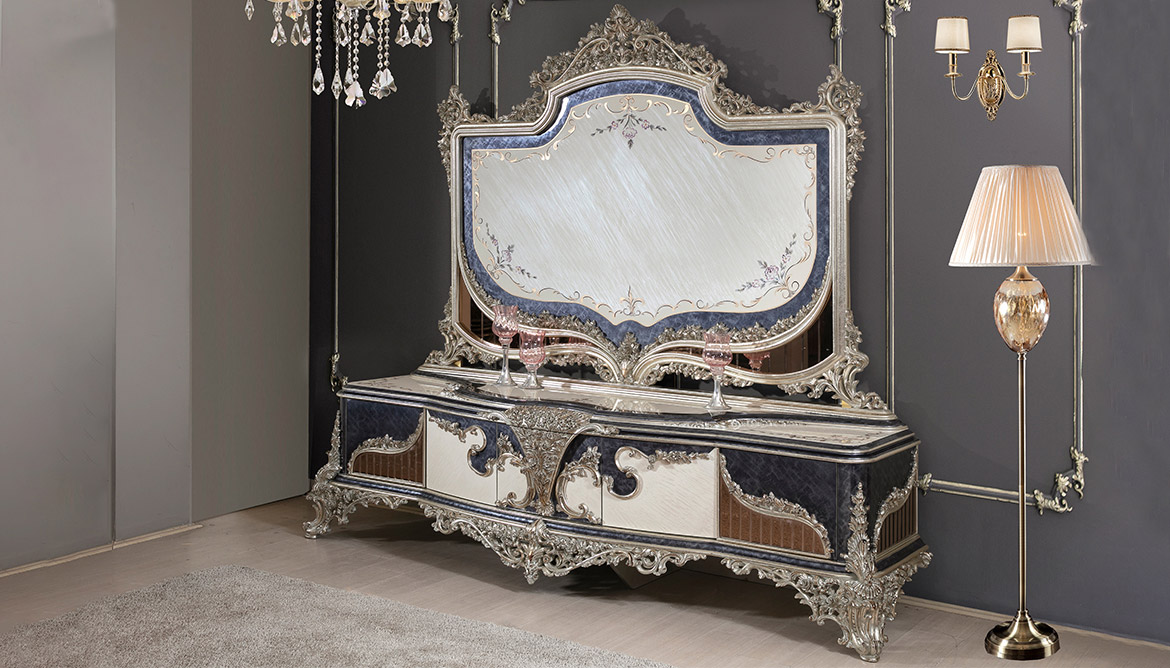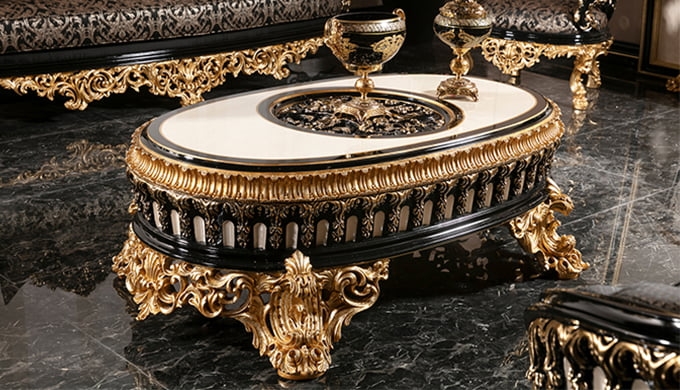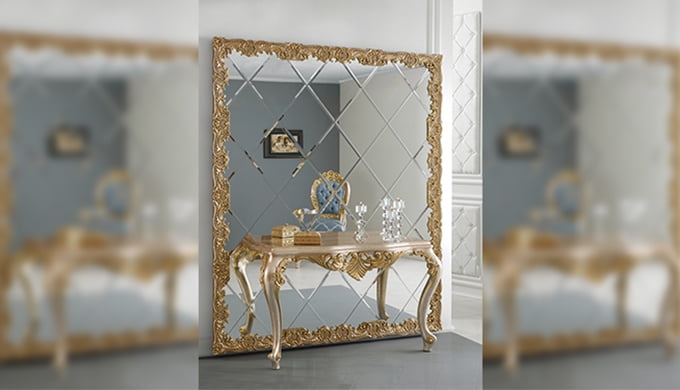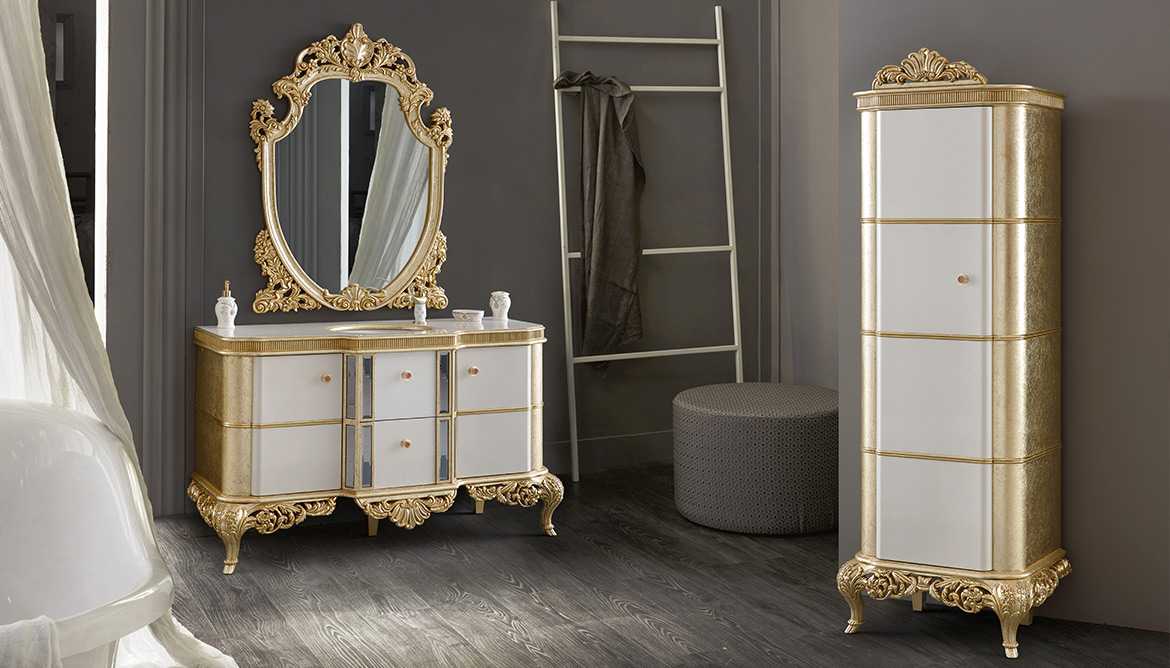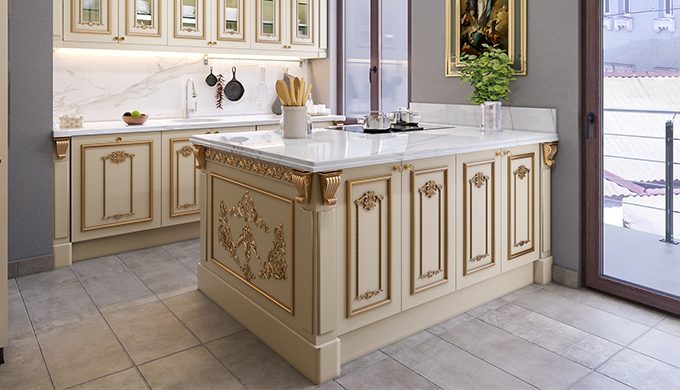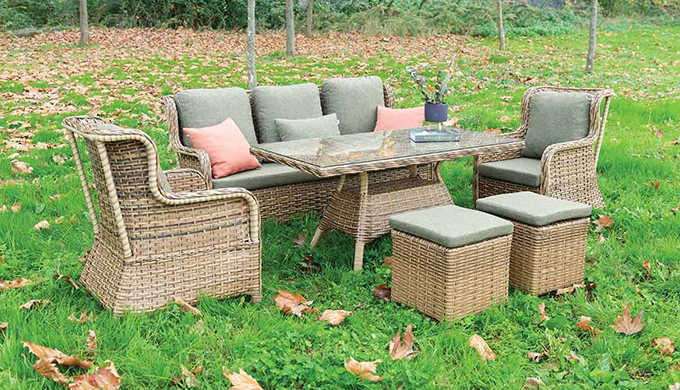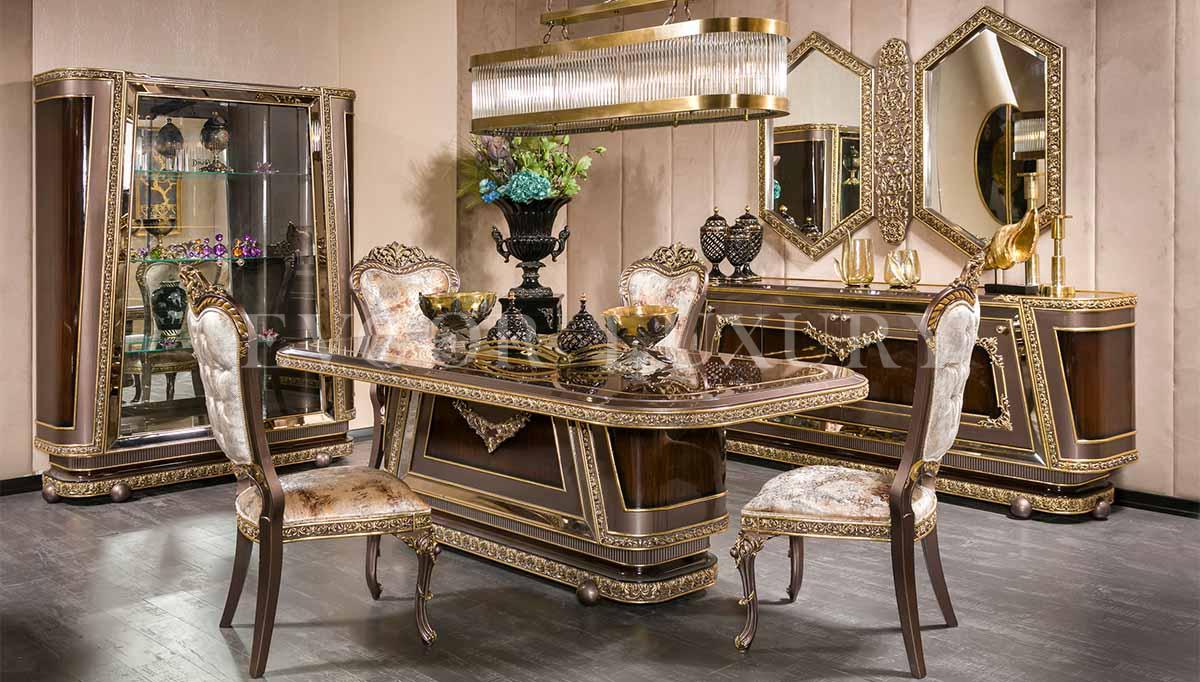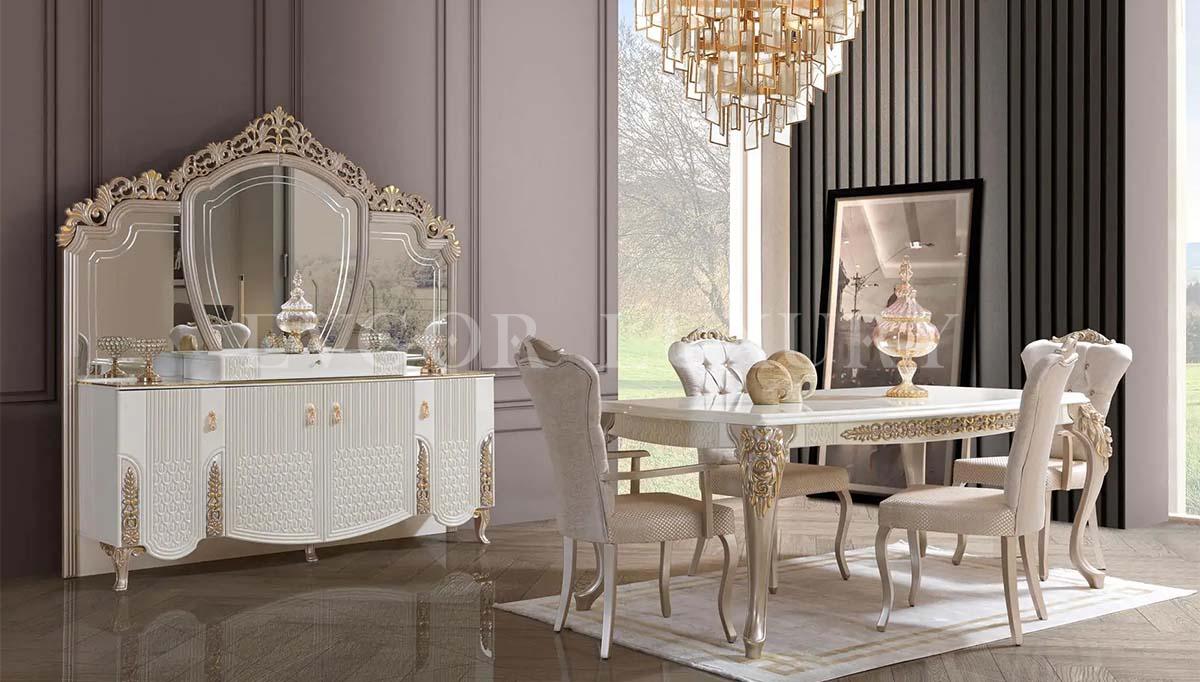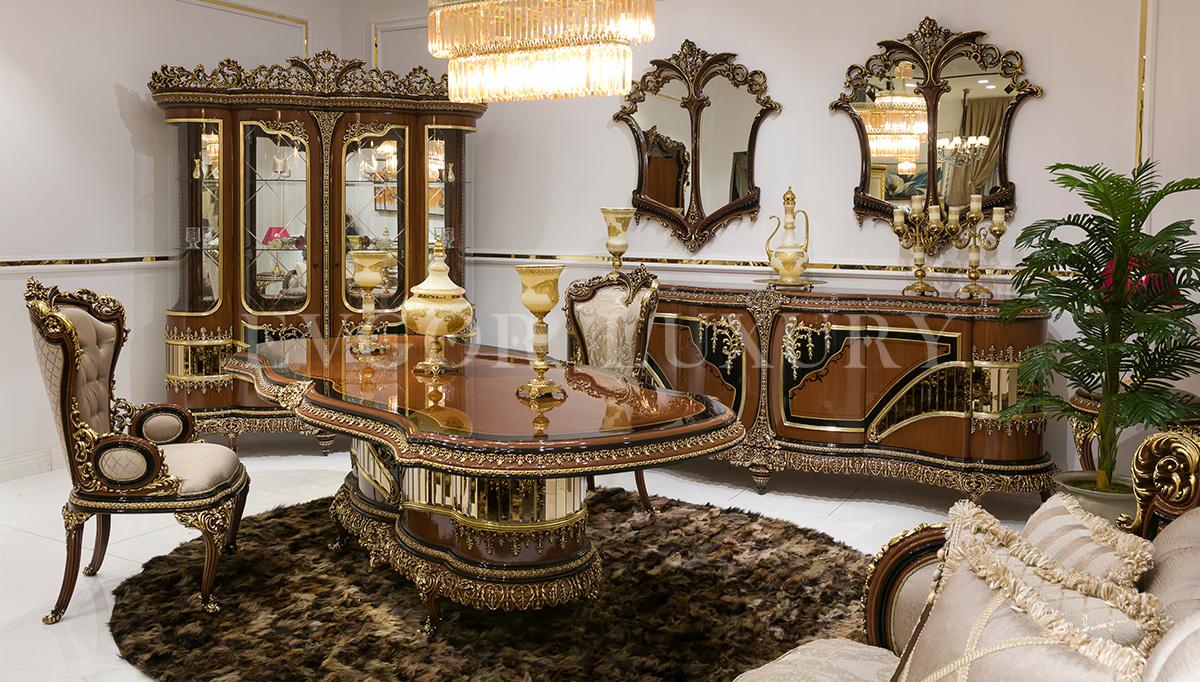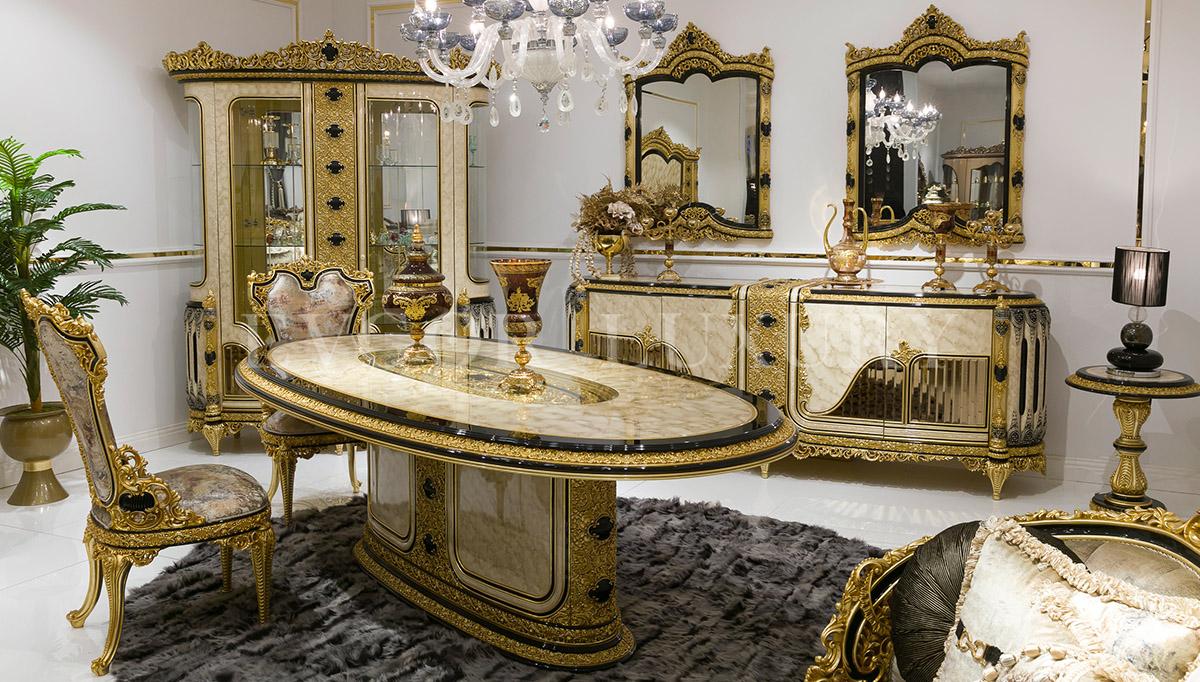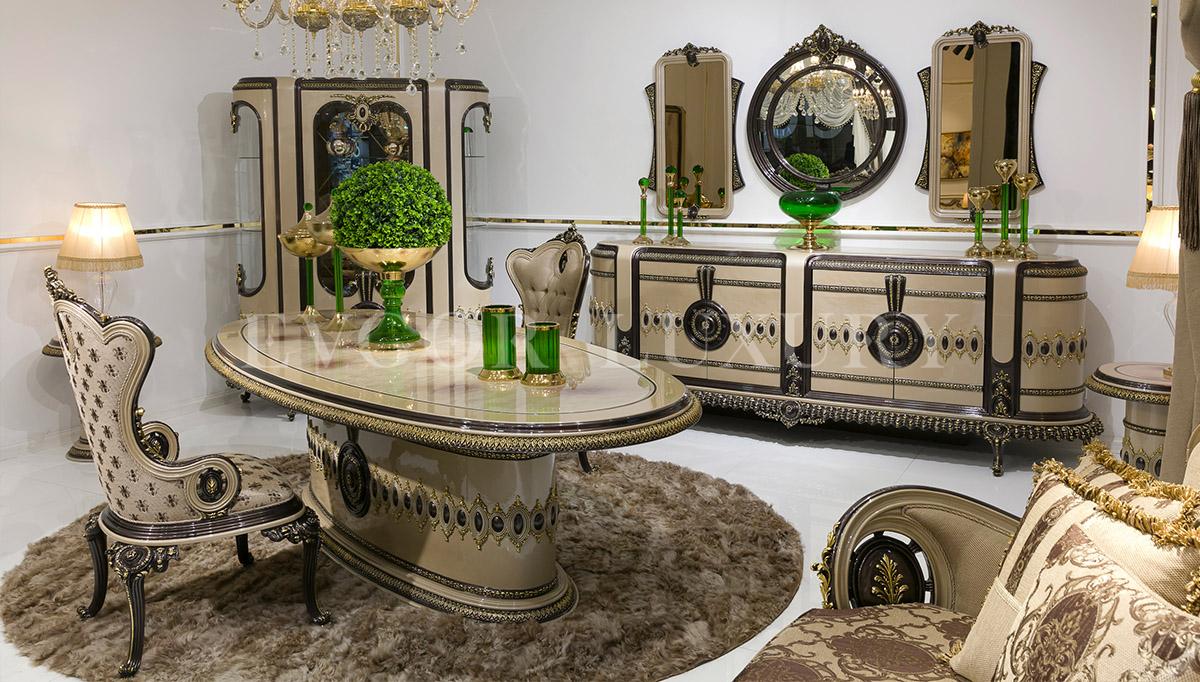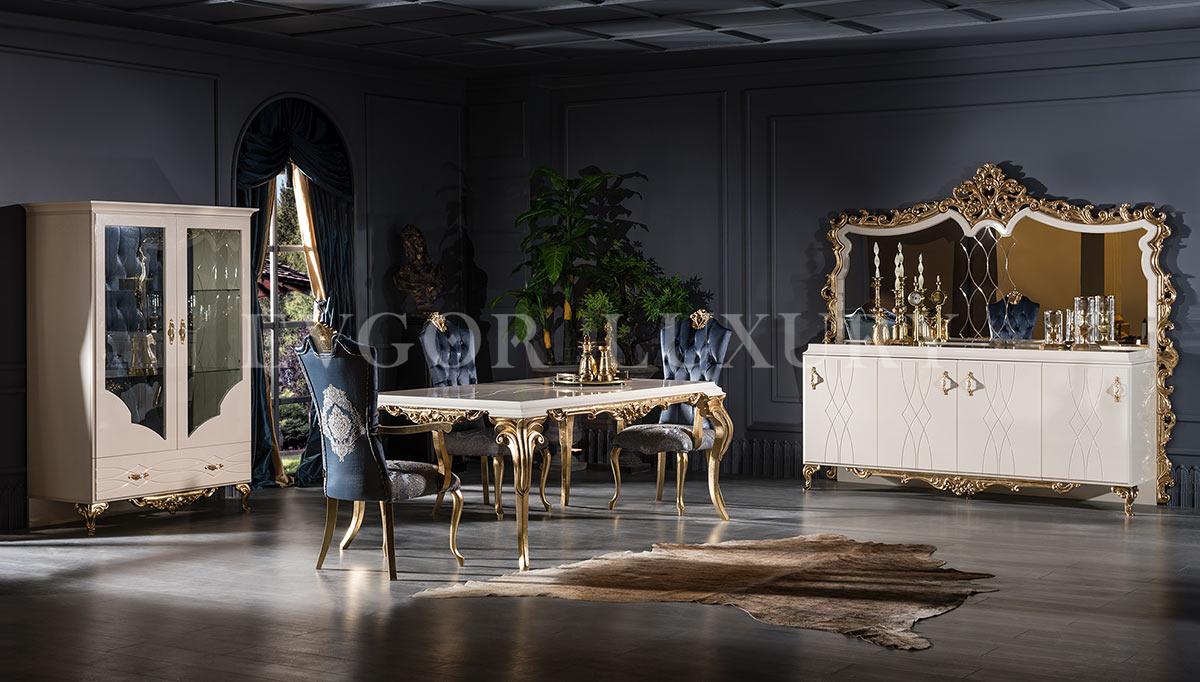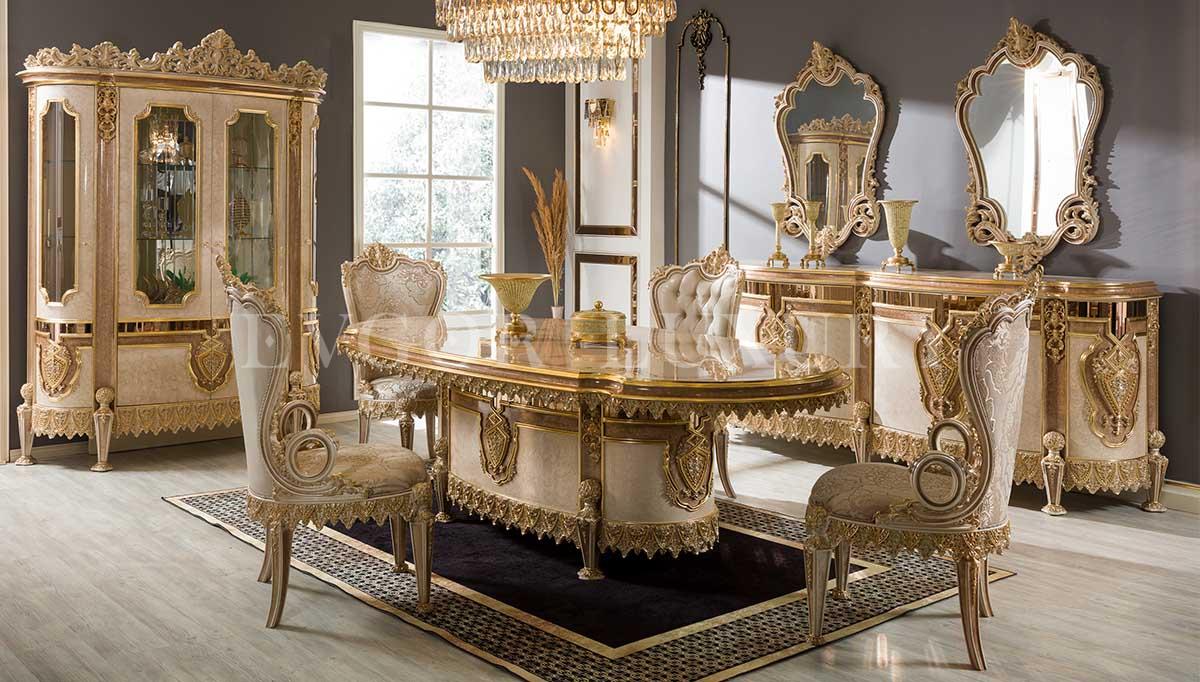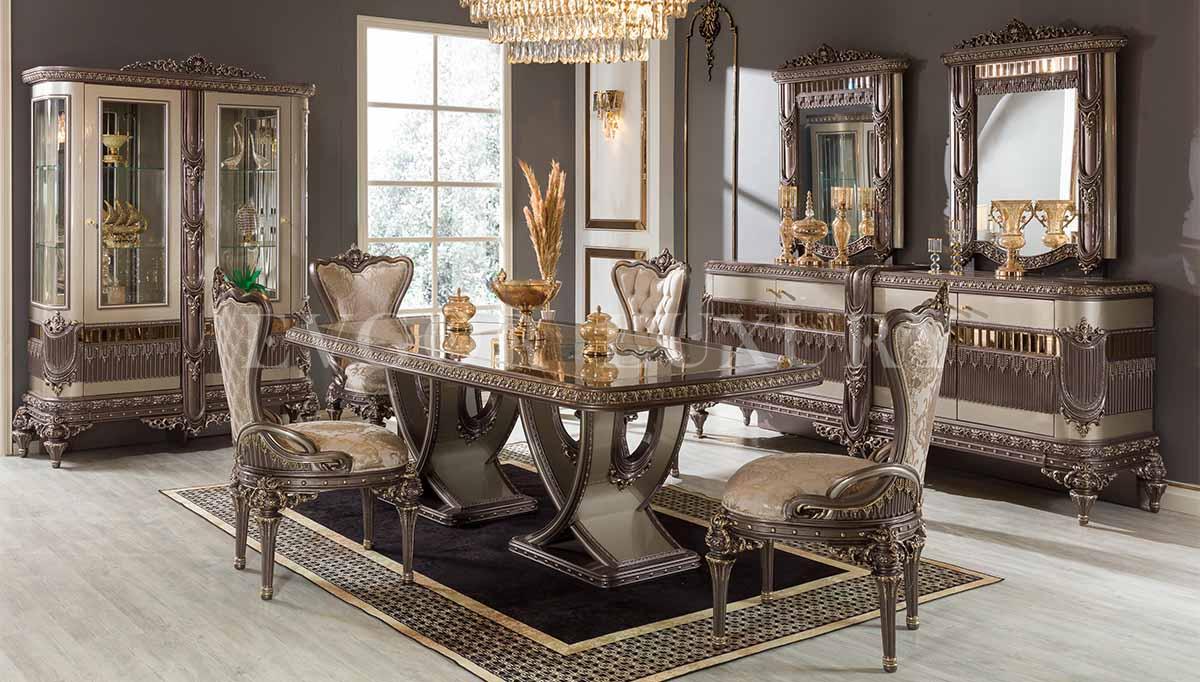Classic Dining Rooms
Classic dining rooms typically feature timeless and elegant designs that evoke a sense of sophistication and tradition. These spaces often incorporate refined furniture, luxurious materials, and a cohesive color palette. Here are key elements and ideas commonly associated with classic dining rooms:
- Traditional Dining Table:
- The centerpiece of a classic dining room is a traditional dining table. This may be an extendable rectangular or round table with sturdy legs and a polished finish. Wood, particularly dark wood like mahogany or cherry, is a common material choice.
- Upholstered Dining Chairs:
- Classic dining chairs are often upholstered for comfort and feature details such as button tufting, nailhead trim, or carved wood accents. Rich fabrics like velvet or damask are commonly used.
- Formal China Cabinet or Buffet:
- A formal china cabinet or buffet adds a touch of elegance to the dining room. These pieces typically showcase fine china, glassware, and other dining accessories. Look for details like glass doors, mirrored backs, and intricate woodwork.
- Chandelier Lighting:
- A statement chandelier is a classic choice for dining room lighting. Crystal chandeliers or fixtures with ornate metalwork can enhance the traditional aesthetic. Ensure that the size of the chandelier suits the scale of the dining table.
- Classic Colors and Patterns:
- Classic dining rooms often feature a refined color palette with neutral tones such as beige, cream, or soft pastels. Traditional patterns like damask, floral, or stripes may be incorporated in upholstery, curtains, or area rugs.
- Crown Molding and Wainscoting:
- Architectural details like crown molding and wainscoting contribute to the classic appeal of the dining room. These features add texture and visual interest to the walls.
- Area Rug:
- An area rug under the dining table can define the dining space and add warmth. Persian or Oriental rugs with intricate patterns are popular choices for classic dining rooms.
- Formal Drapery:
- Floor-to-ceiling draperies or curtains made from luxurious fabrics like silk or damask can enhance the formality of the space. Swag or valance treatments may be added for a more opulent look.
- Classic Art and Wall Decor:
- Consider classic artwork, such as oil paintings or framed prints, to adorn the walls. Mirrors with ornate frames can also be used to reflect light and create a sense of spaciousness.
- Traditional Table Settings:
- Use formal table settings with matching dinnerware, fine china, crystal glassware, and polished silverware. A well-set table contributes to the overall elegance of the dining experience.
- Candlesticks and Centerpieces:
- Classic candlesticks, candelabras, or a floral centerpiece can be placed on the dining table to add a touch of refinement. Consider using fresh flowers or arrangements in classic vases.
- Symmetry and Balance:
- Strive for a sense of symmetry and balance in the arrangement of furniture and decor. Balanced layouts contribute to a harmonious and visually appealing dining space.
- Classic Wall Sconces:
- Wall sconces with classic designs can be added for additional ambient lighting. They complement the central chandelier and contribute to a well-lit and inviting atmosphere.
- Classic Window Treatments:
- Window treatments like drapes or curtains with valances can complete the classic look. Consider using heavy fabrics and traditional patterns for an elegant touch.
- Display Cabinets for Collectibles:
- Incorporate display cabinets for showcasing collectibles, fine china, or decorative items. Glass-fronted cabinets with lighting can create a focal point in the room.
How to Choose the Best Classic Dining Room Sets?
Choosing the best classic dining room set involves considering various factors to ensure that the furniture complements your style, fits the space, and meets your functional needs. Here are some tips to help you select the ideal classic dining room set:
- Define Your Style:
- Classic dining room sets come in various styles, from traditional and formal to more relaxed and transitional. Determine the specific classic style that resonates with your preferences, whether it's characterized by ornate details, dark wood finishes, or more subtle elegance.
- Consider the Size of Your Dining Room:
- Measure the available space in your dining room to determine the size of the dining set that will comfortably fit. Ensure there is ample room for chairs to be pulled out, and leave enough space for movement around the table.
- Choose a Well-Crafted Dining Table:
- The dining table is the focal point of the set. Choose a well-crafted table with a classic design. Common choices include rectangular or round tables with sturdy legs and elegant detailing. Consider the material, such as solid wood with a rich finish.
- Select Coordinating Dining Chairs:
- Choose dining chairs that complement the style of the table. Classic dining chairs are often upholstered with details like button tufting, nailhead trim, or carved wood accents. Ensure that the chairs are comfortable for extended dining sessions.
- Evaluate the Extensibility:
- If you entertain guests frequently, consider an extendable dining table. This feature allows you to adjust the size of the table to accommodate more people when needed.
- Check the Construction and Materials:
- Assess the construction and materials used in the dining set. Look for solid wood construction for durability. High-quality materials and finishes contribute to the longevity and classic appeal of the furniture.
- Consider Storage Options:
- Some classic dining room sets include storage options like buffets, sideboards, or china cabinets. If storage is a priority, choose a set that includes these pieces for both functionality and aesthetics.
- Examine Detailing and Ornamentation:
- Classic dining room sets often feature intricate detailing and ornamentation. Examine the craftsmanship, including carved wood details, inlays, and decorative elements. Choose a set with details that align with your desired level of sophistication.
- Check for Coordinated Pieces:
- Ensure that the dining room set includes coordinated pieces such as buffets, sideboards, or display cabinets. A cohesive set with matching pieces creates a harmonious and well-designed look.
- Think About Upholstery Fabrics:
- Consider the upholstery fabrics used for the chairs. Classic fabrics like velvet, damask, or rich patterns can enhance the traditional aesthetic. Choose fabrics that are both stylish and easy to maintain.
- Color and Finish:
- Consider the color and finish of the dining set in relation to your overall color scheme. Classic dining sets often feature rich, dark finishes, but lighter options are also available. Choose a color that complements your dining room's palette.
- Read Reviews:
- Research customer reviews and testimonials for the specific dining set you are considering. Reviews can provide insights into the durability, comfort, and overall satisfaction of other buyers.
- Visit Showrooms or Galleries:
- If possible, visit showrooms or furniture galleries to see the dining set in person. This allows you to assess the quality, craftsmanship, and overall aesthetic of the furniture before making a purchase.
- Set a Budget:
- Determine a budget for your classic dining room set. While high-end furniture can be an investment, having a budget helps you narrow down options and find a set that aligns with your financial constraints.
Classic Dining Room Prices
When considering the prices of classic dining room sets, here are some factors to keep in mind:
- Brand Reputation: Well-known and reputable furniture brands may command higher prices due to their brand recognition, quality, and craftsmanship.
- Materials Used: The choice of materials, such as solid wood, veneers, and upholstery fabrics, can significantly influence the price. Higher-quality materials often result in a higher cost.
- Design Complexity: Elaborate designs, intricate detailing, and custom features contribute to higher prices. Designer or custom pieces often come with a premium.
- Coordinated Pieces: Dining room sets that include additional pieces like buffets or china cabinets may have higher prices due to the added functionality and design complexity.
- Exclusivity: Exclusive or limited-edition pieces may have higher price points due to their rarity and uniqueness.
- Craftsmanship: Fine craftsmanship and attention to detail, especially handcrafted or artisanal work, can contribute to a higher price.
- Customization Options: The ability to customize the dining set to your preferences, including finishes, fabrics, and design elements, may come with an additional cost.
